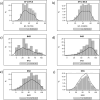Better health-related quality of life is associated with prolonged survival and reduced hospitalization risk among dialysis-dependent chronic kidney disease patients: a historical cohort study
- PMID: 39482605
- PMCID: PMC11526659
- DOI: 10.1186/s12882-024-03835-0
Better health-related quality of life is associated with prolonged survival and reduced hospitalization risk among dialysis-dependent chronic kidney disease patients: a historical cohort study
Abstract
Rationale & objective: End-stage kidney disease (ESKD) negatively affects patients' physical, emotional, and social functioning. Furthermore, adjustment to dialysis require substantial lifestyle changes that may further impact on patients physical and emotional well-being. However, the relationship between Health-Related Quality of life impairment with future adverse outcomes in dialysis is not well characterized. Our study aims to investigate the relationship between Health-Related Quality of Life (HRQoL) and patients' survival and hospitalization rates within a large European dialysis network.
Methods: A historical cohort study was conducted to evaluate association of HRQoL with hospitalization and mortality rates over a 12-month follow-up period. Patients responded to a self-administered survey as part of a Continuous Quality Improvement Program implemented in clinics affiliated with the Spanish FMC-Nephrocare organization. Health-Related Quality of Life (HRQoL) was measured with the KDQOL-36. Potential confounders included socio-demographic characteristics, comorbidities, biochemical parameters, dialysis treatment. We used Cox's Proportional Hazard regression to assess the hazard of death and Logistic Regression to assess the likelihood of hospital admissions during 12-month follow-up period.
Results: A total of 2280 (51.5%) completed the self-administrated survey, and 1838 patients met the inclusion/exclusion criteria of the study. Higher HRQoL scores were associated with significantly lower mortality and hospitalization risk. Risk estimates were robust to adjustment for potential confounders.
Conclusions: Several dimensions of HRQoL are associated with patient-centered outcomes (i.e., mortality and hospitalizations at 1 year). Patient-Reported Outcomes contribute unique pieces of information characterizing patients' health. Residual confounding cannot be fully ruled out; moreover, the high attrition rate could result in selection bias, which may limit the generalizability of the findings to a broader population.
Keywords: Dialysis; End Stage Kidney Disease; Health-Related Quality of Life; Hospitalization; Mortality.
© 2024. The Author(s).
Conflict of interest statement
All authors are employees of Fresenius Medical Care. All the authors declare no commercial or financial conflict of interest.
Figures





Similar articles
-
Burden of Kidney Disease, Health-Related Quality of Life, and Employment Among Patients Receiving Peritoneal Dialysis and In-Center Hemodialysis: Findings From the DOPPS Program.Am J Kidney Dis. 2021 Oct;78(4):489-500.e1. doi: 10.1053/j.ajkd.2021.02.327. Epub 2021 Apr 16. Am J Kidney Dis. 2021. PMID: 33872688
-
Health-related quality of life associated with risk of death in Brazilian dialysis patients: an eight-year cohort.Qual Life Res. 2021 Jun;30(6):1595-1604. doi: 10.1007/s11136-020-02734-9. Epub 2021 Jan 16. Qual Life Res. 2021. PMID: 33454887
-
Is health-related quality of life trajectory associated with dialysis modality choice in advanced chronic kidney disease?Perit Dial Int. 2024 Jul;44(4):254-264. doi: 10.1177/08968608231217807. Epub 2024 Jan 7. Perit Dial Int. 2024. PMID: 38186013
-
Psychosocial interventions for preventing and treating depression in dialysis patients.Cochrane Database Syst Rev. 2019 Dec 2;12(12):CD004542. doi: 10.1002/14651858.CD004542.pub3. Cochrane Database Syst Rev. 2019. PMID: 31789430 Free PMC article.
-
Health-Related Quality of Life in End-Stage Renal Disease Patients: How Often Should We Ask and What Do We Do with the Answer?Blood Purif. 2016;41(1-3):218-24. doi: 10.1159/000441462. Epub 2016 Jan 15. Blood Purif. 2016. PMID: 26766028 Review.
Cited by
-
Assessing Quality of Life in Hemodialysis Patients in Kazakhstan: A Cross-Sectional Study.J Clin Med. 2025 Jul 16;14(14):5021. doi: 10.3390/jcm14145021. J Clin Med. 2025. PMID: 40725715 Free PMC article.
References
-
- Brown EA, Zhao J, McCullough K, et al. Burden of Kidney Disease, Health-Related Quality of Life, and Employment Among Patients Receiving Peritoneal Dialysis and In-Center Hemodialysis: Findings From the DOPPS Program. Am J Kidney Dis. 2021;78(4):489–e5001. 10.1053/j.ajkd.2021.02.327. - PubMed
-
- Raoofi S, Pashazadeh Kan F, Rafiei S, et al. Hemodialysis and peritoneal dialysis-health-related quality of life: systematic review plus meta-analysis. BMJ Support Palliat Care. 2023;13:365–73. 10.1136/bmjspcare-2021-003182. - PubMed
MeSH terms
LinkOut - more resources
Full Text Sources
Medical
Miscellaneous

